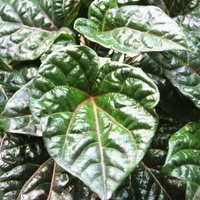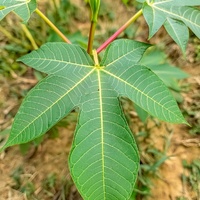Common name: Slippery cabbage
Other common names: Aibika, Bele, Bush cabbage, Bush spinach, Edible hibiscus, Hibiscus spinach, Lettuce tree, New Guinea spinach, Pacific cabbage, Pele, Sunset hibiscus, Tree spinach
Description
Slippery Cabbage or Aibika is a fast-growing shrub in the Hibiscus family producing edible leaves and originates over a wide geographic area extending from Southeast Asia to Melanesia, a region in the Pacific encompassing Papua New Guinea, the Solomon Islands and New Caledonia.
It grows unattended up to 4 m (13 ft) tall but, in cultivation, is kept pruned to between 1.5 and 2 m (5 and 6 ft) to facilitate harvesting the leaves, which are cooked as a vegetable.
There are many varieties, which are mainly distinguishable by the shape of the leaves. The leaves are deep green, large, up to 30 cm (12 in) long and almost as wide, and come either heart-shaped or in various lobed to palmate forms, ranging from shallow to deeply lobed and from smooth to wavy-margined. The leaf stalks and veining colour can also be different, depending on the variety, being green or red.
The flowers are like those of Okra and other closely related Hibiscus species, with pale yellow petals and purple centres. When fertilised, they develop into green seedpods that are also okra-like in appearance.
Use
The leaves and tender leaf stalks are steamed, stir-fried, or added to soups, stews, or curries to impart their rich flavour and mucilaginous quality, thickening the sauce.
If not being cooked right away, the harvested leaves and their stalks can be stored dampened in an air-tight container in the refrigerator, which will keep them fresh for up to three days.
The smooth-margined varieties are more forgiving than the lobed or palmate varieties when it comes to their harvesting. The latter's leaves needing to be harvested very young as they tend to become tough and fibrous if left on the plant for too long. Harvesting should be carried out in the cooler hours of the day to prevent wilting.
It is most commonly grown in the home garden and is usually closely spaced in rows to grow into an edible hedge or privacy screen.
Health use
The cooked leaves and tender stalks contain high levels of Beta-carotene and good supplies of Folate, Calcium, Magnesium and Potassium.
Climate
Grows naturally and is productive in humid tropical climates, but can be grown as an annual in cool climates, generally across areas with annual lows of 12 to 25°C, annual highs of 22 to 35°C, annual rainfall of 1200 to 5000 mm and a dry season of 4 months or less. In warm areas with evenly distributed rainfall, it grows fast and produces lush, green leaves. In arid areas or in the dry season, the leaves quickly become leathery and fibrous.
Growing
New plants are usually started from cuttings taken from selected varieties. Cuttings of mature wood around 50 cm (1.5 ft) long are taken and planted one-thirds to one-half deep into soil that has been enriched with organic matter. If not being planted right away, the cuttings can be left to stand cut end in water for a few days, with the water changed daily to avoid stem rot.
Growth performance is best in rich, free-draining clay-loam, loam, sandy-loam and loamy-sand soils of an acid to neutral nature, generally with a pH of 5.0 to 7.0 and on sites with full to partial sun exposure. It has poor tolerance to drought, limestone soils, waterlogging or shade conditions, which result in reduced leaf production and a high incidence of disease.
Mulching is needed to prevent the soil from drying but should be kept a few centimetres clear of the main stem not to encourage stem rot.
It needs manuring and cutting back or re-planting every eighteen to twenty-four months to maintain a continuous supply of leaves throughout the year. Otherwise, it becomes woody and unproductive.
Problem features
It is listed as a weed in at least one reference publication. Still, there does not appear to be any record of it being a serious weed anywhere in the world, despite its widespread cultivation in the tropics. It is assessed as a low weed risk for Hawaii by The Hawaii Pacific Weed Risk Assessment (HPWRA) project.
Where it grows
References
Books
-
Elevitch, C. R & Wilkinson, K. M. 2000, Agroforestry Guides for Pacific Islands, 1st ed., Permanent Agriculture Resources, Holualoa, Hawaii
-
Grubben, G.J.H. & Denton, O.A. (Editors) 2004, Plant Resources of Tropical Africa, Volume 2 : Vegetables, PROTA Foundation, Backhuys Publishers, Leiden
-
Hu, S. 2005, Food plants of China, Chinese University Press, Hong Kong
-
Parrotta, J. A. 2001, Healing plants of peninsular India, CABI Publishing, Wallingford, Oxfordshire
-
Randall, R. P. 2002, A global compendium of weeds, R.G. and F.J. Richardson Press, Melbourne
-
Randall, R. P. 2007, The introduced flora of Australia and its weed status, Cooperative Research Centre for Australian Weed Management, Glen Osmond, South Australia
-
Tindall, H. D 1983, Vegetables in the Tropics, Macmillan Press, London
-
Toensmeier, E. 2007, Perennial Vegetables : From Artichokes to Zuiki Taro, A Gardener's Guide to Over 100 Delicious and Easy to Grow Edibles, White River Junction, Chelsea Green Publishing, Vermont
-
Walter, Annie & Lebot, Vincent & Sam, Chanel & Ferrar, P. (Paul) & Walter, Annie. Fruits of Oceania et al. 2007, Gardens of Oceania, Australian Centre for International Agricultural Research, [Canberra]



